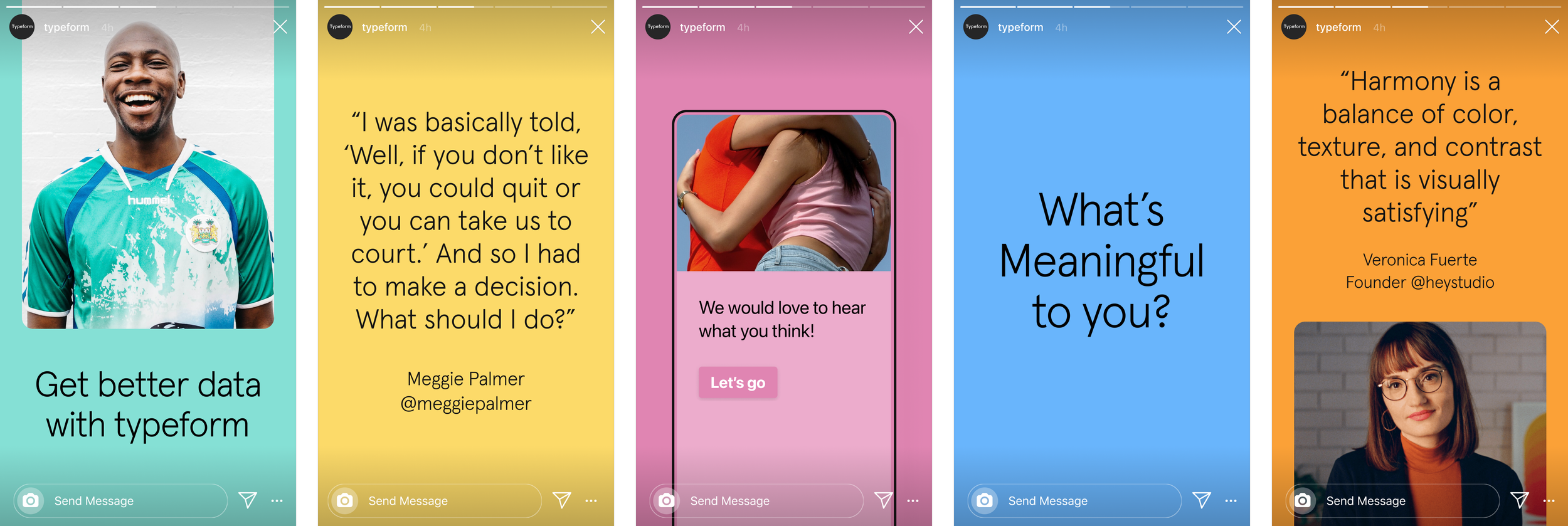Typeform has been at the forefront of online form and survey software since its inception. In 2018, they faced a pivotal moment in their brand evolution, mirroring their transition from a spirited startup to an established industry leader.
Typeform's visual expression had begun evolving towards something simpler, bolder, and more elegant. However, the use of bold colors and modular shapes wasn't unique in the market. They needed to differentiate themselves without starting from scratch.
The challenge was clear: create a visual identity that was more distinctive, memorable, and impactful while staying true to Typeform's core mission of bringing people closer through better conversations.
Leveraging Typeform's expertise in facilitating meaningful digital interactions, we zoomed in on what makes them unique in a crowded market of online forms and surveys.
If other platforms prioritize efficiency and data collection, what's the opposite edge of this spectrum? How can a product feel more like a catalyst for genuine connections rather than just a tool?
The concept of a window to better conversations. We transformed Typeform's existing modular shape into an inviting portal, symbolizing the gateway to richer, more meaningful interactions that Typeform enables.
The visual system we developed includes the following elements:
A Dynamic Window Concept. Inspired by Josef Albers and Van Doesburg, we incorporated motion to create a sense of depth and perspective, inviting exploration.
Thoughtful Color Treatment. Drawing from Albers' work, we developed color combinations that create optical illusions of depth, turning every visual into a conversation starter.
Relatable Illustration Style. We created characters and spot illustrations that embrace the beautiful imperfections of real human connections.
Expressive Typography. We chose a variable font to represent the diversity of conversations and languages, emphasizing inclusivity and adaptability.
New Wordmark. Typeform’s original logo used Aperçu typeface without any customization. This typeface was also employed for all communications, resulting in a logotype that lacked distinctiveness and recognizability.
To address this, we partnered with Laura Meseguer to recreate the wordmark, ensuring that it would be both versatile and easily identifiable, in line with our design-led approach. Through careful refinements in letter spacing and deliberate modifications to the shapes of specific characters, such as the 'y', 'e', and 'f', we achieved a subtle yet impactful transformation.
The result is a more organic wordmark that resonates with the art of writing while upholding its original attributes of strength, clarity, and immediate recognition.
By working closely with Typeform's executive, product, design, and marketing teams, we amplified their core strengths while paving new roads for a more inclusive, ever-changing environment of digital interactions.
The new identity doesn't just represent Typeform—it embodies their mission. Every color, shape, and motion is an invitation to users to create their own meaningful interactions.
This evolution wasn't about discarding Typeform's past. It was about reamplifying their most unique traits and using design to craft symbols, stories, and opportunities that shape how people connect in the digital world.
The result is a visual ecosystem that doesn't just look different, it feels different. It transforms Typeform from a tool into an experience, from a means of data collection into a facilitator of genuine connections.
In the landscape of digital interactions, Typeform now stands not just as a platform, but as a gateway to better conversations. They've redefined what it means to engage online, proving that even in the digital realm, meaningful connections are not just possible – they're essential.
*This project was completed during Claudia’s time at Typeform







